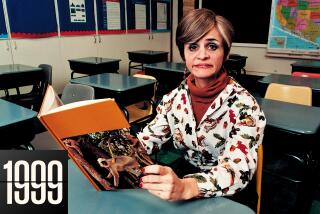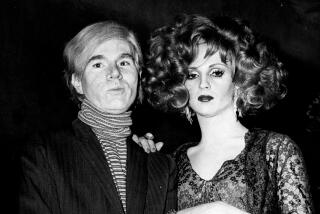Comic Actor John Candy Dies at Mexico Filming Site : Entertainment: Star of ‘SCTV’ and ‘Planes, Trains & Automobiles’ was 43. He reportedly suffered a heart attack.
- Share via
John Candy, the hefty comic who rose to fame in a series of slapstick films that brought smiles to the faces of studio financiers and shrieks of delight from his audiences, died Friday in Mexico, where he was filming.
The star of “Uncle Buck,” “Planes, Trains & Automobiles,” “Stripes” and many other films was 43.
Hector Partida, a spokesman for the government of Durango state, 400 miles northwest of Mexico City, said Candy was stricken in his sleep and was found dead in his trailer when paramedics arrived.
“It happened very quickly; it was a massive heart attack,” Partida said. “Even the first-aid crew, when they got there, found him dead.”
The production of “Wagons East,” in which Candy was playing the drunken wagon master of an 1860s prairie schooner heading the wrong way, was suspended.
The 6-foot-3, 300-pound TV and movie veteran had won two Emmys. In addition to battling a weight problem most of his life, Candy was reported to be a heavy smoker.
At his death, Candy was diversifying his multitude of talents and most recently completed the Fox television movie comedy, “Hostage for a Day,” his directorial debut.
He was trying, friends said, to move beyond the knockabout, satiric style that had first endeared him to TV and then movie audiences.
In the film “Only the Lonely,” he had assumed a more serious role as a Chicago policeman who falls in love and must choose between his girlfriend and breaking a mother’s bonds.
“I think I have the ability and I’d like to exercise that and stretch, if you will, to take other roles on,” Candy said in a 1991 interview.
But his death probably will limit an assessment of his career to those early pictures in which he fumbled, stumbled and usually fell while trying in vain to be of some use to somebody.
Wrote Mike McGrady of New York Newsday in 1986:
“Sincere, intense, well-intentioned, naive, he is constantly digging and redigging his own grave. His appeal is phenomenal.
“He has been in more turkeys than stuffing mix, yet everyone seems to love him. . . . Given a role with meat to it . . . John Candy reveals himself to be an accomplished comic actor.”
The shy, genial actor and writer, who was legendary for his spontaneous wit and ability as a teller of tales, until recently had avoided interviews.
He attributed that in part to still being self-conscious despite his fame.
“I was a real heavy kid,” he said in an interview with The Times three years ago. “I didn’t go out on a lot of dates; Saturday nights I stayed home and watched Carol Burnett with my parents.”
An only child who entertained himself with comic books and horror films, Candy said he completely understood the angst felt by Danny Muldoon, the policeman in “Only the Lonely,” as he fought to untie the apron strings his mother had knotted about him.
It was, he said, a much more difficult challenge than if the roles had involved lovers rather than loving combatants.
Candy’s last big hit was 1993’s “Cool Runnings,” about the Jamaican bobsled team. Before that he had been in the 1990 blockbuster, “Home Alone,” which set box-office records.
Unlike many stars who surround themselves with a retinue of loyalists while making pictures, Candy was known to mingle freely with his co-workers, from grips to carpenters to fellow actors.
He sometimes gave each of the women working on his pictures roses on Valentine’s Day or remembered his crew with candy or small gifts at other times.
John Franklin Candy was born in Toronto. His father died a few years after his birth on Oct. 31, 1950, and he was raised by his mother, his aunt and his grandparents. He attended Roman Catholic schools and competed in football and hockey, but admitted to not being particularly skillful in either sport.
He remained interested in athletics, and after gaining wealth as an entertainer, he became a co-owner of the Canadian Football League’s Toronto Argonauts with Los Angeles Kings owner Bruce McNall and Kings star Wayne Gretzky.
As a boy he was fascinated with films, particularly those of George Burns and Gracie Allen, Abbott and Costello, and the Three Stooges. “Lassie” and “Howdy Doody” were among his childhood TV favorites.
He gravitated toward acting and began to appear in local stage productions while studying journalism and theater at Centennial College in Toronto.
He worked at odd jobs, selling sporting goods and paper supplies while dabbling in children’s stage productions and underground theater.
In 1971 he met another struggling Canadian actor--Dan Aykroyd--who was sorting mail for the Canadian postal service. At Aykroyd’s urging he auditioned for the Chicago Second City troupe, where the future stars of “Saturday Night Live” were hanging out.
With John Belushi, Gilda Radner, Bill Murray and Aykroyd he established the ties that would lead to SCTV (Second City Television) in Toronto, and their half-hour skits were soon picked up in syndication by NBC and sent to 45 American cities.
The network expanded the program to 90 minutes in 1981 and put it on the air after “The Tonight Show With Johnny Carson.”
Candy acted and wrote for “SCTV Network,” and won writing Emmys in 1981 and 1982. The show was a deliciously biting lampoon of everything on commercial TV, including such icons as Perry Como.
Among its lasting contributions to American counterculture was “The Fracases, America’s Nastiest Couple,” and “The Great White North,” a spoof of two Canadian brothers with red necks and a spectacularly limited view of the world around them.
Candy became famous for his impressions of Luciano Pavarotti and Julia Child and for his half-crazed characters: The chain-smoking egoist Johnny LaRue, the late-night horror show host Dr. Tongue, and one of the polka enthusiasts known as the Shmnenge Brothers Happy Wanderers.
“Individually the Second City TV performers were merely brilliant and inspired; as a group, they were visionary,” said a Village Voice critic.
But the late-hour time slot crippled ratings and “SCTV” went off the air in 1983.
Candy said the show accomplished one thing: “We increased the sale of VCRs (because) nobody stayed up.”
Discouraged, he left TV but not acting.
Film director Steven Spielberg had seen Candy earlier and gave him a small part in “1941,” a comedy about the days after Pearl Harbor. Much of what he and Aykroyd did in the film was eliminated in the final cut, but he considered it his first major film break. Earlier he had appeared in several long-forgotten Canadian pictures.
His next major picture was “The Blues Brothers” in 1980 with Aykroyd and Belushi. He was parole officer Burton Mercer, constantly and hilariously frustrated in his pursuit of Jake and Elwood Blues.
Next he had a small part in the Army comedy “Stripes,” playing opposite another SCTV veteran, Murray.
After a series devoted to the worst movies ever made (“It Came From Hollywood”), Candy made “National Lampoon’s Vacation” and “Going Berserk.”
In the latter film he portrayed the fiance of a congressman’s daughter who is brainwashed and tries to assassinate his future father-in-law.
“Loved him, hated it,” was the critical reaction, particularly in Variety, which found Candy “irresistible.”
In 1984 he played Freddie Bauer, the lovable lecher in “Splash.” The Washington Post said that role, supporting Tom Hanks, “should establish Candy as an audience favorite.” And it did.
Although he continued to make films that caused critics to moan (“Brewster’s Millions” and “Summer Rental”), he was becoming more than a cult favorite while establishing the inept good-guy image that marked his oeuvre.
“Armed and Dangerous” in 1986 failed commercially and critically but “Volunteers,” about the misadventures of some Peace Corps members, succeeded artistically if not commercially.
With “Planes, Trains & Automobiles” in 1987, Candy emerged as a major star.
He and Steve Martin portrayed two disparate and desperate travelers trying to get home.
“Candy has never been more boisterously cracked than he is here,” said the Post.
Said Martin on learning of his colleague’s death:
“John Candy was a gentleman and a great comic talent. I count myself extremely lucky to have had the opportunity to work with him.”
While initially appealing to sophisticated insomniacs on television, Candy’s glory became such that by 1989 he was able to sustain a show while being heard but not seen as the chief counselor at “Camp Candy,” a Saturday morning animated children’s TV show. There he battled the evil Rex de Forrest, who wanted to tear down the camp and replace it with condominiums.
He interspersed film appearances with TV specials. He was host of “Jackie Gleason, the Great One” and “Best of SCTV,” among others.
Privately, Candy lived a quiet life with his wife, Rosemary, and two children in homes in Toronto and Los Angeles.
He also had made his peace with studio executives, many of whom considered him a jolly fat man and had placed him in many inferior films.
Several years ago he recalled how disappointed he was with the film work that followed the brilliant, biting years of “SCTV.”
“My agent is always telling me, ‘It’s not called show art, it’s show business,’ and I have to learn that until the money comes out of your pockets, you can rant and rave all you want, but they hold the purse strings.”
Cable TV’s “Comedy Central” has scheduled a special tribute to Candy for Saturday evening.
* AN APPRECIATION: F1
Candy’s Career
The film and television credits of John Candy, who died Friday:
FILMS
* “Face of the Lady,” 1971
* “Class of ‘44,” 1973
* “It Seemed Like a Good Idea,” 1975
* “Tunnelvision,” 1976
* “The Clown Murders,” 1976
* “Find the Lady,” 1976
* “The Silent Partner,” 1978
* “Lost and Found,” 1979
* “1941,” 1979
* “The Blues Brothers,” 1980
* “Double Negative,” 1980
* “Stripes,” 1981
* “It Came From Hollywood,” 1982
* “Going Berserk,” 1983
* “National Lampoon’s Vacation,” 1983
* “Splash,” 1984
* “Brewster’s Millions,” 1984
* “Sesame Street Presents: Follow That Bird,” 1985
* “Summer Rental,” 1985
* “Volunteers,” 1985
* “Canadian Conspiracy,” 1986
* “Armed and Dangerous,” 1986
* “Little Shop of Horrors,” 1986
* “Spaceballs,” 1987
* “Planes, Trains & Automobiles,” 1987
* “The Great Outdoors,” 1988
* “Speed Zone!” 1989 (also titled “Cannonball Fever”)
* “Uncle Buck,” 1989
* “Who’s Harry Crumb?,” 1989
* “Home Alone,” 1990
* “Masters of Menace,” 1990
* “Nothing but Trouble,” 1991
* “Delirious,” 1991
* “JFK,” 1991
* “Only the Lonely,” 1991
* “Once Upon a Crime,” 1992
* “Cool Runnings,” 1993
TELEVISION
* “Second City T.V.,” 1977-79
* “SCTV Network 90,” 1981-83
* “Hostage for a Day,” 1993
(director; not yet broadcast)
Source: Associated Press
More to Read
Sign up for Essential California
The most important California stories and recommendations in your inbox every morning.
You may occasionally receive promotional content from the Los Angeles Times.










